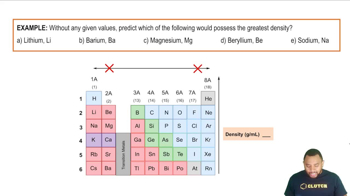Ch.22 - Chemistry of the Nonmetals

Brown15th EditionChemistry: The Central ScienceISBN: 9780137542970Not the one you use?Change textbook
Chapter 22, Problem 69
Complete the exercises below. Write the formulas for the following compounds and indicate the oxidation state of the group 4A element or boron in each: a. boric acid, b. silicon tetrabromide, c. lead(II) chloride.
 Verified step by step guidance
Verified step by step guidance1
Identify the chemical formula for boric acid. Boric acid is a compound containing boron, hydrogen, and oxygen. Its chemical formula is H3BO3.
Determine the oxidation state of boron in boric acid. In H3BO3, hydrogen has an oxidation state of +1 and oxygen has an oxidation state of -2. Use the formula: 3(+1) + x + 3(-2) = 0 to solve for x, the oxidation state of boron.
Identify the chemical formula for silicon tetrabromide. Silicon tetrabromide is a compound consisting of one silicon atom and four bromine atoms. Its chemical formula is SiBr4.
Determine the oxidation state of silicon in silicon tetrabromide. In SiBr4, bromine typically has an oxidation state of -1. Use the formula: x + 4(-1) = 0 to solve for x, the oxidation state of silicon.
Identify the chemical formula for lead(II) chloride. Lead(II) chloride is a compound consisting of one lead atom and two chlorine atoms. Its chemical formula is PbCl2. The oxidation state of lead in this compound is indicated by the Roman numeral II, which is +2.
Key Concepts
Here are the essential concepts you must grasp in order to answer the question correctly.
Oxidation State
The oxidation state, or oxidation number, is a measure of the degree of oxidation of an atom in a compound. It indicates the number of electrons that an atom can gain, lose, or share when forming chemical bonds. For example, in lead(II) chloride (PbCl2), lead has an oxidation state of +2, meaning it has lost two electrons.
Recommended video:
Guided course

Oxidation Numbers
Group 4A Elements
Group 4A elements, also known as Group 14 in the periodic table, include carbon, silicon, germanium, tin, and lead. These elements typically exhibit a variety of oxidation states, commonly +4 and +2, depending on the compound they form. Understanding their common oxidation states is crucial for determining the oxidation state in compounds like silicon tetrabromide (SiBr4) and lead(II) chloride.
Recommended video:
Guided course

Main Group Elements: Density Example
Chemical Formulas
Chemical formulas represent the composition of a compound, indicating the types and numbers of atoms present. For example, boric acid is represented as H3BO3, showing it contains three hydrogen atoms, one boron atom, and three oxygen atoms. Writing accurate chemical formulas is essential for identifying compounds and understanding their properties and reactions.
Recommended video:
Guided course

Skeletal Formula
Related Practice
